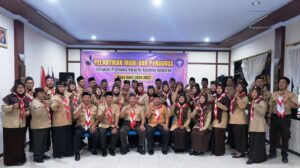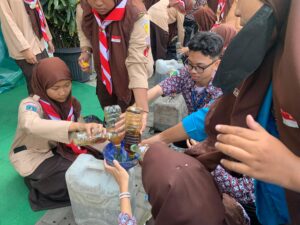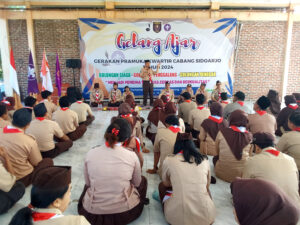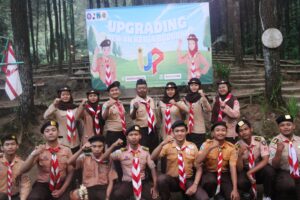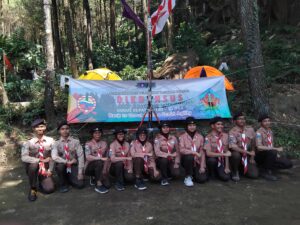Sejarah Kepramukaan Dunia
Lebih dari 500 juta orang muda dan dewasa telah mengambil bagian dalam Pramuka sejak didirikan lebih dari satu abad yang lalu. Masing-masing bergabung dengan Gerakan untuk menjadi warga negara yang aktif dan menciptakan perubahan positif di komunitas mereka.
Saat ini, Kepramukaan adalah gerakan pendidikan pemuda terkemuka di dunia dengan lebih dari 57 juta Pramuka di lebih dari 200 negara dan wilayah di seluruh dunia. Melalui perpaduan unik antara pendidikan, petualangan, dan kesenangan, Pramuka terus menjadi inspirasi bagi kaum muda untuk menjadi warga negara yang aktif yang terlibat dalam menciptakan dunia yang lebih baik dan berkelanjutan.

Copyright
© World Scout Bureau Inc. / The Scout Association
1907 – 1908
Early Beginnings
- Scouting began as a programme for boys aged 11 to 18.
- 1907: The first experimental camp organised by Robert Baden-Powell with 20 boys at Brownsea Island, United Kingdom was a great success.
- 1908: Baden-Powell published “Scouting for Boys”, which was an immediate hit and has since sold over 100 million copies.

Copyright
© World Scout Bureau Inc.
1909 – 1918
Expansion of the Scout Movement
- 1909: “Scouting for Boys” was translated into five languages. It produced a Movement that quickly adopted the name “The Boy Scouts”.
- 1909: A Scout rally in London attracted more than 11,000 Scouts.
- 1910: Baden-Powell started the Girl Guides under the leadership of his sister, Agnes.
- 1914: The Patrol System was established to ensure the stability of Scouting through World War I, as Patrol Leaders volunteered in place of adult leaders.
- 1916: Cub Scouts was started for boys under the age of 11, supported by the publication of the “Wolf Cub’s Handbook” and using Rudyard Kipling’s “Jungle Book” as a framework.
- 1918: Rover Scouts was formed for older boys and young adults.

Copyright
© World Scout Bureau Inc. / World Scouting
1919 – 1922
Scouting’s World Events and Governance
- 1920: The first World Scout Conference (then known as the International Scout Conference) took place during the first World Scout Jamboree in London, United Kingdom, with 33 National Scout Organizations in attendance.
- 1920: The World Scout Bureau (then known as the Boy Scouts International Bureau) was established in London, United Kingdom.
- 1922: The 2nd World Scout Conference was held Paris, France, with 31 National Scout Organizations represented. Global membership stood at just over 1 million Scouts.
- 1922: The first World Scout Committee (then Boy Scouts International Committee) was elected.

Copyright
World Scout Bureau Inc. / World Scouting
1914 – 1945
The World Wars
- Between the two world wars, Scouting continued to flourish, except in totalitarian regions where Scouting activities were banned. In occupied countries and in those with totalitarian regimes, Scouting continued in secret with Scouts playing important roles in the resistance and underground movements.
- Scouts supported their countries through the world wars by feeding the hungry and helping the injured. In some places, Seas Scouts acted as coast guards.

Copyright
© World Scout Bureau Inc. / World Scouting
1945 – 1980
The Evolution of Scouting
- 1947: World Organization of the Scout Movement was granted General Consultative Status to the United Nations Economic and Social Council (UNESCO).
- 1960-1980: Many countries gained their independence, resulting in National Scout Organizations joining or rejoining as members of World Organization of the Scout Movement.
- 1980-2007: Scouting re-emerged in every country where it had existed before World War II and started across newly independent countries in the Commonwealth of Independent States following the Cold War.
- Scouting in developing countries gradually evolved into a Youth Programme, which was designed by local Scout leaders to better meet the needs of their communities.
- Scouts became more involved with social, economic, and environmental issues in their communities and countries.

Copyright
WSB Inc. / Jean-Pierre POUTEAU
2007
A Century of Scouting
- The Scout Movement celebrated its 100th anniversary by returning to its roots in the United Kingdom for the 21st World Scout Jamboree.
- On 1 August, millions of Scouts from around the world celebrated the Scout Movement and its growth from humble beginnings to becoming a global Movement with millions of members in nearly every country around the world.

2010 – 2020
Promoting Peace and Sustainability
- Scouting continued to expand its membership – reaching even remote islands in the Pacific and Caribbean – while innovating and adapting its educational offerings to reflect the current needs and aspirations of young people.
- 2011: The Messengers of Peace initiative was created to promote peace building and support Scouting’s impact on local communities.
- 2018: Scouts for SDGs was launched with the aim of engaging the Scout Movement in making the world’s largest coordinated youth contribution to the SDGs.
- 2020: The Earth Tribe was launched as a global youth community for environmental action and to enable young people to tackle the impacts of climate change.

2020 – 2022
Global Pandemic
- 2020-2022: Scouts around the world showed the Movement’s resilience by taking action to support their communities and adapting to global restrictions through virtual and at-home programmes.
- 2020: The Global Youth Mobilization was launched in an effort to support the development of young people in a post-pandemic world. It is as a partnership with the Big 6 Youth Organisations, which is comprised of the World Organization of the Scout Movement, World Association of Girl Guides and Girl Scouts, World Alliance of Young Men’s Christian Association, World Young Women’s Christian Association, International Federation of Red Cross and Red Crescent Societies, and The Duke of Edinburgh’s International Award.
Robert Baden-Powell
Robert Baden-Powell, the founder of Scouting, was an educator, soldier, and prolific writer, who presented the ideas and theory behind Scouting in his bestselling book “Scouting for Boys”. He is popularly known as B-P.
https://www.scout.org/media/oembed?url=https%3A//www.youtube.com/watch%3Fv%3DFW4OymlM8sM&max_width=0&max_height=0&hash=KhXwSww54B4gm4IFwEwoncHRPQCKjyDI38mr1-8OaI8

Copyright
© World Scout Bureau Inc. / World Scouting
Early Life
- Born Robert Stephenson Smyth Baden-Powell in London on 22 February 1857, B-P was the son of an Oxford University professor and the eighth of ten children.
- B-P received his early education from his mother, and later won a scholarship to the Charterhouse School, one of Britain’s most prestigious institutes.
- At Charterhouse, he began to turn his attention to the great outdoors, hiding out in the woods around the school to track wildlife, catch, and cook rabbits, all while being careful not to let the tell-tale smoke give his position away. Holidays with his brothers also consisted of many adventures where B-P fine-tuned his outdoor skills and craftsmanship.

Serving in the Military
- From 1876 to 1903, B-P served in the military, starting in India and then the Balkans, West Africa, South Africa and Malta. As a young army officer, he specialised in map-making and reconnaissance, and soon began to train other soldiers in what were essential skills for soldiers at the time.
- B-P’s methods were considered unorthodox. He set up small units or patrols who worked together under a single leader and made sure there was special recognition for those who did well. The proficiency badges he awarded then resembled the traditional design of the north compass point, and today’s universal Scout badge remains remarkably similar.
- After a successful military campaign in South Africa, B-P returned home in 1903 a national hero.

Beginnings of the Scout Movement
- After learning that young people were reading his books and practicing what he had written for soldiers, B-P reworked his book “Aids to Scouting” for a younger audience. This became “Scouting for Boys”.
- In 1907, he organised what is now known as the first experimental camp on Brownsea Island, off the coast of Dorset, where he put some of his ideas into practice. He brought together 20 boys from different economic backgrounds and took them camping. This event marked the start of the Scout Movement, and is commemorated with a foundation stone on the island.
- “Scouting for Boys” had been written as a training guide for existing youth organisations, but it soon became the handbook of the new Scouting Movement. The book has since been translated into all of the world’s major languages.

Family Life
- After retiring from the army in 1910 to devote his life to the Scout Movement, B-P travelled the world to inspire young people. Two years later, he married Olave St Clair Soames, who like her husband was also born on 22 February.
- Olave was B-P’s constant companion and supporter, as the two worked closely around the development of the Scout Movement. She would later become World Chief Guide and co-founder of the Girl Guides Movement.
- The couple went on to have three children: Peter, Heather, and Betty.

Copyright
© World Scout Bureau Inc. / World Scouting
Chief Scout of the World
- By 1920, the Scout Movement was large enough to hold its first mass gathering, later known as a Jamboree. Close to 8,000 Scouts from 34 countries gathered for the first World Scout Jamboree beneath the glass-covered dome of London’s Olympia – the floor covered in earth especially for the occasion so that Scouts could pitch their tents. As the event drew to a close, B-P was acclaimed the Chief Scout of the World, a title that he would hold until his death.
- Nine years later, at the 3rd World Scout Jamboree, the Prince of Wales announced that B-P would be given a peerage. B-P took the title of Baron Baden-Powell of Gilwell, honouring Gilwell Park as the location of the international training centre he had established for Scout Leaders.

Copyright
© World Scout Bureau Inc. / World Scouting
Legacy
- With his health declining, B-P returned to Africa in 1938 to live in semi-retirement in the shadow of Mount Kenya at Nyeri.
- B-P died on 8 January 1941 at the age of 83. He had written a farewell message for Scouts to be published only after his death, in which he urged them to “try and leave this world a little better than you found it”.
- Throughout his life, B-P inspired generations of young people. He wrote at least 32 books and received honorary degrees from at least six universities as well as numerous other orders, decorations, and 19 foreign Scout awards.
“Try and leave this world a little better than you found it.”

Robert Baden-Powell
Founder of the Scout Movement
Sejarah Pramuka dunia dan Baden Powell
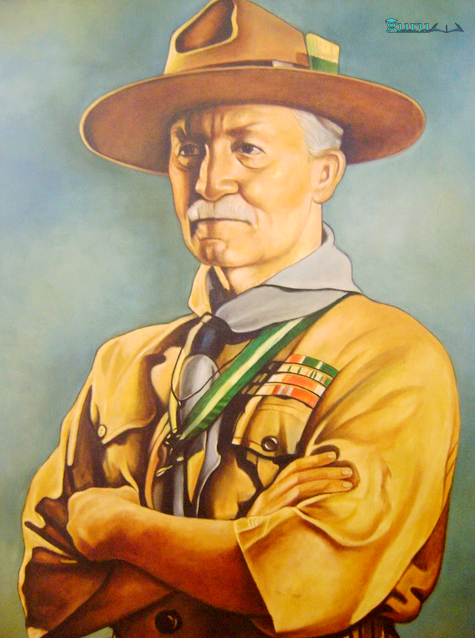

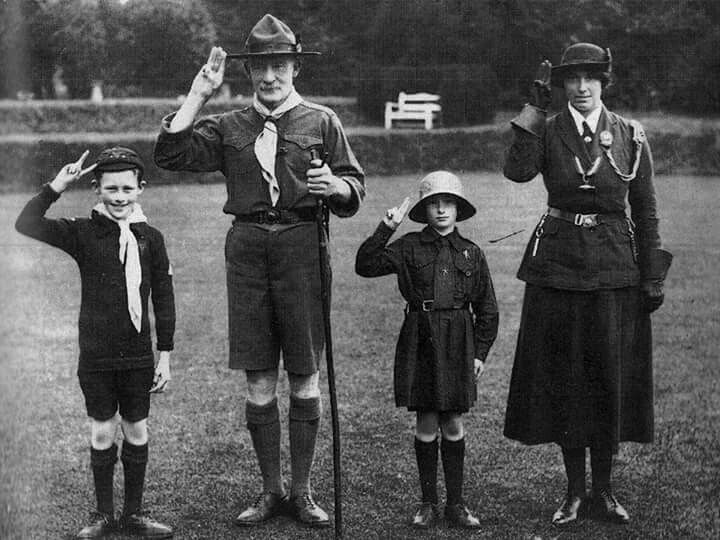

A. Pendahuluan
Kalau kita mempelajari sejarah pendidikan kepramukaan kita tidak dapat lepas dari riwayat hidup pendiri gerakan kepramukaan sedunia Lord Robert Baden Powell of Gilwell.
Hal ini disebabkan pengalaman beliaulah yang mendasari pembinaan remaja di negara Inggris. Pembinaan remaja inilah yang kemudian tumbuh berkembang menjadi gerakan kepramukaan.
B. Riwayat hidup Baden Powell
Lahir tanggal 22 Pebruari 1857 dengan nama Robert Stephenson Smyth. Ayahnya bernama powell seorang Professor Geometry di Universitas Oxford, yang meninggal ketika Stephenson masih kecil.
Pengalaman Baden Powell yang berpengaruh pada kegiatan kepramukaan banyak sekali dan menarik diantaranya :
- Karena ditinggal bapak sejak kecil, maka mendapatkan pembinaan watak ibunya.
- Dari kakaknya mendapat latihan keterampilan berlayar, berenang, berkemah, olah raga dan lain-lainnya.
- Sifat Baden Powell yang sangat cerdas, gembira, lucu, suka main musik, bersandiwara, berolah raga, mengarang dan menggambar sehingga disukai teman-temannya.
- Pengalaman di India sebagai pembantu Letnan pada Resimen 13 Kavaleri yang berhasil mengikuti jejak kuda yang hilang di puncak gunung serta keberhasilan melatih panca indera kepada Kimball O’Hara.
- Terkepung bangsa Boer di kota Mafeking, Afrika Selatan selama 127 hari dan kekurangan makan.
- Pengalaman mengalahkan Kerajaan Zulu di Afrika dan mengambil kalung manik kayu milik Raja Dinizulu.
Pengalaman ini ditulis dalam buku “Aids To Scouting” yang merupakan petunjuk bagi Tentara muda Inggris agar dapat melaksanakan tugas penyelidik dengan baik. William Smyth seorang pimpinan Boys Brigade di Inggris minta agar Baden Powell melatih anggotanya sesuai dengan pengalaman beliau itu.
Kemudian dipanggil 21 pemuda dari Boys Brigade di berbagai wilayah Inggris, diajak berkemah dan berlatih di pulau Browns Sea pada tanggal 25 Juli 1907 selama 8 hari.
Tahun 1910 BP pensiun dari tentara dengan pangkat terakhir Letnan Jenderal. Pada tahun 1912 menikah dengan Ovale St. Clair Soames dan dianugerahi 3 orang anak. Beliau mendapat titel Lord dari Raja George pada tahun 1929 Baden Powell meninggal tanggal 8 Januari 1941 di Nyeri, Kenya, Afrika.
C. Sejarah Kepramukaan Sedunia
Awal tahun 1908 Baden Powell menulis pengalamannya untuk acara latihan kepramukaan yang dirintisnya. Kumpulan tulisannya ini dibuat buku dengan judul “Scouting For Boys”. Buku ini cepat tersebar di Inggris dan negara-negara lain yang kemudian berdiri organisasi kepramukaan yang semula hanya untuk laki-laki dengan nama Boys Scout.
Tahun 1912 atas bantuan adik perempuan beliau, Agnes didirikan organisasi kepramukaan untuk wanita dengan nama Girl Guides yang kemudian diteruskan oleh istri beliau.
Tahun 1916 berdiri kelompok pramuka usia siaga dengan nama CUB (anak serigala) dengan buku The Jungle Book karangan Rudyard Kipling sebagai pedoman kegiatannya. Buku ini bercerita tentang Mowgli si anak rimba yang dipelihara di hutan oleh induk serigala.
Tahun 1918 beliau membentuk Rover Scout bagi mereka yang telah berusia 17 tahun. Tahun 1922 beliau menerbitkan buku Rovering To Success (Mengembara Menuju Bahagia). Buku ini menggambarkan seorang pemuda yang harus mengayuh sampannya menuju ke pantai bahagia.
Tahun 1920 diselenggarakan Jambore Dunia yang pertama di Olympia Hall, London. Beliau mengundang pramuka dari 27 Negara dan pada saat itu Baden Powell diangkat sebagai Bapak Pandu Sedunia (Chief Scout of The World).
- Jambore Dunia I diselenggarakan pada tahun 1920 di Olympia, Kensington, London, Inggris
- Jambore Dunia II diselenggarakan pada tahun 1924 di Ermelunden, Denmark
- Jambore Dunia III diselenggarakan pada tahun 1929 di Birkenhead, Inggris dengan mengusung tema Coming of Age
- Jambore Dunia IV diselenggarakan pada tahun 1933 di Gödöllő, Hungaria
- Jambore Dunia V diselenggarakan pada tahun 1937 di Vogelenzang, Bloemendaal, Belanda
- Jambore Dunia VI diselenggarakan pada tahun 1947 di Moisson, Prancis dengan mengusung tema Jamboree of Peace
- Jambore Dunia VII diselenggarakan pada tahun 1951 di Bad Ischl, Austria dengan tema Jamboree of Simplicity
- Jambore Dunia VIII diselenggarkan pada tahun 1955 di Niagara-on-the-Lake, Kanada dengan tema New Horizons
- Jambore Dunia IX diselenggarakan pada tahun 1957 di Sutton Park, Inggris mengusung tema 50th Anniversary of Scouting
- Jambore Dunia X diselenggarakan pada tahun 1959 di Los Baños, Laguna, Filipina dengan tema Building Tomorrow Today
- Jambore Dunia XI diselenggarakan pada tahun 1963 di Marathon, Greece dengan tema Higher and Wider
- Jambore Dunia XII diselenggarakan pada tahun 1967 di Farragut State Park, Amerika Serikat mengusung tema For Friendship
- Jambore Dunia XIII diselenggarakan pada tahun 1971 di Fujinomiya, Jepang bertemakan For Understanding
- Jambore Dunia XIV diselenggarakan pada tahun 1975 di Lillehammer, Norwegia bertemakan Five Fingers, One Hand
- Jambore Dunia XV seharusnya diselenggarakan pada tahun 1979 di Neyshâbûr, Iran namun dibatalkan
- Jambore Dunia XV pengganti diselenggarakan pada tahun 1983 di Calgary, Kanada dengan tema The Spirit Lives On
- Jambore Dunia XVI diselenggarakan antara tahun 1987 dan 1988 di Sydney, Australia mengusung tema Bringing the World Together
- Jambore Dunia XVII diselenggarakan pada tahun 1991 di Gunung Seorak, Korea Selatan dengan tema Many Lands, One World
- Jambore Dunia XVIII diselenggarakan pada tahun 1995 di Flevoland, Belanda mengusung tema Future is Now
- Jambore Dunia XIX tercatat diselenggarakan pada tahun 1998-1999 di Picarquín, Chili bertemakan Building Peace Together
- Jambore Dunia XX tercatat diselenggarakan pada tahun 2002-2003 di Sattahip, Thailand mengusung tema Share our World, Share our Cultures
- Jambore Dunia XXI diselenggarakan pada tahun 2007 di Hylands Park, Inggris dengan tema One World, One Promise Scouting Centenary
- Jambore Dunia XXII diselenggarakan pada tahun 2011 di Rinkaby, Swedia dengan tema Simply Scouting
- Jambore Dunia XXIII diselenggarakan pada tahun 2015 di Kirarahama, Jepang dengan tema A Spirit of Unity
- Jambore Dunia XXIV diselenggarakan pada tahun 2019 di The Summit Bechtel Family National Scout Reserve, West Virginia, Amerika Serikat bertema Unlock a New World
Tahun 1914 beliau menulis petunjuk untuk kursus Pembina Pramuka dan baru dapat terlaksana tahun 1919. Dari sahabatnya yang bernama W.F. de Bois Maclarren, beliau mendapat sebidang tanah di Chingford yang kemudian digunakan sebagai tempat pendidikan Pembina Pramuka dengan nama Gilwell Park.
Tahun 1920 dibentuk Dewan Internasional dengan 9 orang anggota dan Biro Sekretariatnya di London, Inggris dan tahun 1958 Biro Kepramukaan sedunia dipindahkan dari London ke Ottawa Kanada. Tanggal 1 Mei 1968 Biro kepramukaan Sedunia dipindahkan lagi ke Geneva, Swiss.
Sejak tahun 1920 sampai 19 Kepala Biro Kepramukaan Sedunia dipegang berturut-turut oleh Hebert Martin (Inggris). Kolonel J.S. Nilson (Inggris), Mayjen D.C. Spry (Kanada) yang pada tahun 1965 diganti oleh R.T. Lund 1 Mei 1968 diganti lagi oleh DR. Laszio Nagy sebagai Sekjen.
Biro Kepramukaan sedunia Putra mempunyai 5 kantor kawasan yaitu Costa Rica, Mesir, Philipina, Swiss dan Nigeria. Sedangkan Biro kepramukaan Sedunia Putri bermarkas di London dengan 5 kantor kawasan di Eropa, Asia Pasifik, Arab, Afrika dan Amerika Latin.

